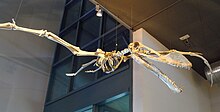bio.wikisort.org - Animal
Les Ornithocheiroidea constituent un clade éteint de ptérosaures. Il représente le groupe principal des ptérodactyloïdes euptérodactyloïdes[2].

Pteranodon longiceps (adulte mâle).
| Règne | Animalia |
|---|---|
| Embranchement | Chordata |
| Classe | Archosauria |
| Ordre | † Pterosauria |
| Sous-ordre | † Pterodactyloidea |
| Clade | † Lophocratia |
| Infra-ordre | † Eupterodactyloidea |
Clade
Taxons de rang inférieur
- † Piksi
- † Pteranodontia
- † Azhdarchoidea
Ils ont vécu au cours du Crétacé, et leurs fossiles ont été découverts sur tous les continents à l'exception de l’Antarctique[3].
Définitions

Coloborhynchus spielbergi.
Le paléontologue S. Christopher Bennett a défini les Ornithocheiroidea en 1994 comme un clade basé sur des apomorphies ; il est rattaché au clade des Eupterodactyloidea[1].
En 2003, Alexander Kellner le définit comme le clade le moins inclusif contenant Anhanguera blittersdorffi, Pteranodon longiceps, Dsungaripterus weii et Quetzalcoatlus northropi[4]. Plus tard, la même année, David Unwin propose une définition plus restrictive : un clade contenant Pteranodon longiceps et Istiodactylus latidens[5]. Dans ses publications de 2008, 2010 et 2014, Brian Blake Andres, conserve la définition de Kellner (2003) pour éviter toute confusion avec d'autres groupes ayant déjà des définitions similaires comme les Pteranodontoidea[6],[7].
Super-famille ?
Conformément à son suffixe, Paleobiology Database, en 2022, l'a noté comme une super-famille[8].
Classification
Les résultats des études phylogénétiques sur les Ornithocheiroidea et plus généralement sur les ptérosaures sont nombreux et souvent contradictoires. Le cladogramme ci-dessous, établi par Longrich, Martill et Andres en 2018, montre la position des Ornithocheiroidea au sein des Eupterodactyloidea, et les principaux taxons qu'il renferme[2]. Les études phylogénétiques de Vidovic et Martill en 2017 aboutissent à un résultat très différent avec deux grands ensembles sous les Ornithocheiroidea : les Azhdarchoidea et les Dsungaripteromorpha[9] :
| Pterodactyloidea |
| ||||||||||||||||||||||||||||||||||||||||||||||||||||||
Voir aussi
- Pterodactyloidea
- Eupterodactyloidea
- Phylogénie des Pterosauria
Liens externes
- Ressource relative au vivant :
Notes et références
- (en) S. Christopher Bennett, « Taxonomy and systematics of the Late Cretaceous pterosaur Pteranodon (Pterosauria, Pterodactyloidea) », Occasional Papers of the Natural History Museum of the University of Kansas, vol. 169, , p. 1–70 (lire en ligne)
- (en) Longrich NR, Martill DM, Andres B, « Late Maastrichtian pterosaurs from North Africa and mass extinction of Pterosauria at the Cretaceous-Paleogene boundary », PLoS Biology, vol. 16, no 3, , e2001663 (PMID 29534059, PMCID 5849296, DOI 10.1371/journal.pbio.2001663)
- (en) Richard J. Butler, Stephen L. Brusatte, Brian B. Andres et Roger B. J. Benson, « How do geological sampling biases affect studies of morphological evolution in deep time? A case study of the Pterosauria (Reptilia: Archosauria) », Evolution, vol. 66, no 1, , p. 147–162 (PMID 22220871, DOI 10.1111/j.1558-5646.2011.01415.x)
- (en) Kellner, A. W. A., (2003): Pterosaur phylogeny and comments on the evolutionary history of the group. pp. 105-137. — in Buffetaut, E. & Mazin, J.-M., (eds.): Evolution and Palaeobiology of Pterosaurs. Geological Society of London, Special Publications 217, London, 1-347
- (en) Unwin, D. M., (2003): On the phylogeny and evolutionary history of pterosaurs. pp. 139-190. — in Buffetaut, E. & Mazin, J.-M., (eds.): Evolution and Palaeobiology of Pterosaurs. Geological Society of London, Special Publications 217, London, 1-347
- (en) Brian Blake Andres, Systematics of the Pterosauria, Yale University, , 366 p. (lire en ligne) A preview that shows the cladogram without clade names
- (en) B. Andres, J. Clark et X. Xu, « The Earliest Pterodactyloid and the Origin of the Group », Current Biology, (DOI 10.1016/j.cub.2014.03.030)
- (en) Référence Paleobiology Database : †superfamily Ornithocheiroidea Seeley 1870 (pterosaur) (consulté le ).
- (en) S.U. Vidovic et D.M. Martill, « The taxonomy and phylogeny of Diopecephalus kochi (Wagner, 1837) and "Germanodactylus rhamphastinus" (Wagner, 1851) », Geological Society, London, Special Publications, vol. 455, , p. 125–147 (DOI 10.1144/SP455.12, lire en ligne)
Références taxonomiques
- (en) Référence Paleobiology Database : Ornithocheiroidea Seeley, 1870
- Portail de la paléontologie
- Portail de l’herpétologie
На других языках
[es] Ornithocheiroidea
Los ornitoqueiroideos (Ornithocheiroidea) son un grupo de pterosaurios del suborden Pterodactyloidea.- [fr] Ornithocheiroidea
Другой контент может иметь иную лицензию. Перед использованием материалов сайта WikiSort.org внимательно изучите правила лицензирования конкретных элементов наполнения сайта.
WikiSort.org - проект по пересортировке и дополнению контента Википедии
